Blog
October 17th, 2017

Well, here we are. Our book has been out for a year, and already (for us, anyway) it has transformed from a celebration of women’s accomplishments to a laundry list of battles in need of fighting all over again. The new president has been in power mere months, and already he and his toadies have singled out the most vulnerable among us to be blamed, excluded, punished, even crushed. As artists, we feel our path is clear, our work is cut out for us: the hard part is choosing where to start, upon which injustice to focus first. In the end, the oppressors chose for us, with a seemingly endless succession of outrages against Latino-Americans and Central-American immigrants: the border wall, ICE raids, the DACA repeal, Joe Arpaio’s tent cities and later pardon, the list goes on. And since nobody spoke truth to power like Mexican artist Frida Kahlo, who better to preside over this broadside?
Feet, what do I need you for when I have wings to fly?
Frida’s life story is the stuff of legends, and one that many of us know by heart. So rather than travel the well-trodden ground of her accident and illnesses, or her relationships with Diego Rivera and famous men and women of her era, we paid homage to Frida’s artwork instead. (Even our edition number is symbolic of Frida’s body of work: she created approximately 200 paintings in her lifetime.) Estados Divididos is largely inspired by two of Frida’s paintings:
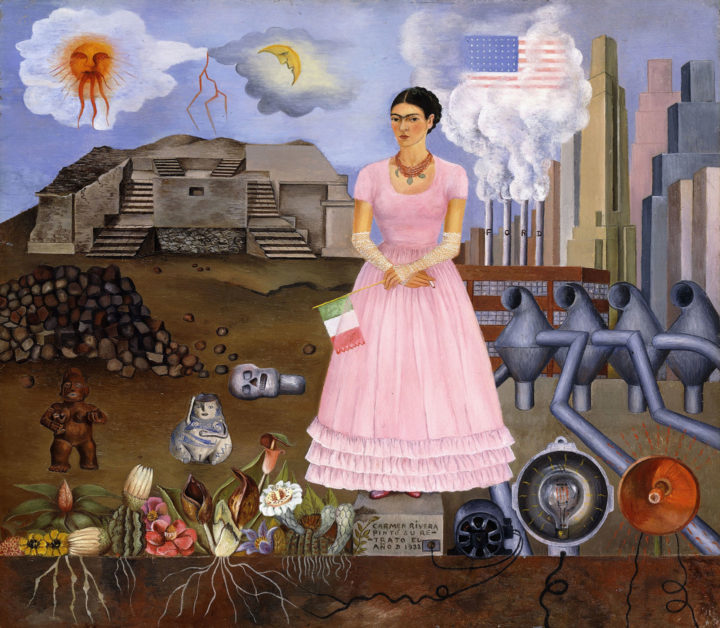
The first is Self Portrait Along the Border Between Mexico and the United States, which she painted in 1932 in Detroit, while Diego worked on a mural commission there. It’s painted on tin, in the Mexican folk tradition of retrablos or devotional paintings. She signed the piece with the name Carmen Rivera, perhaps as a tongue-in-cheek response to the way Americans would have referred to “the wife of the artist.” Interestingly, Diego insisted that she was the real artist in the family, calling her “la pintura más pintor,” using both the feminine and masculine form of the word painter in reference to her prowess (and possibly her androgyny, as well).
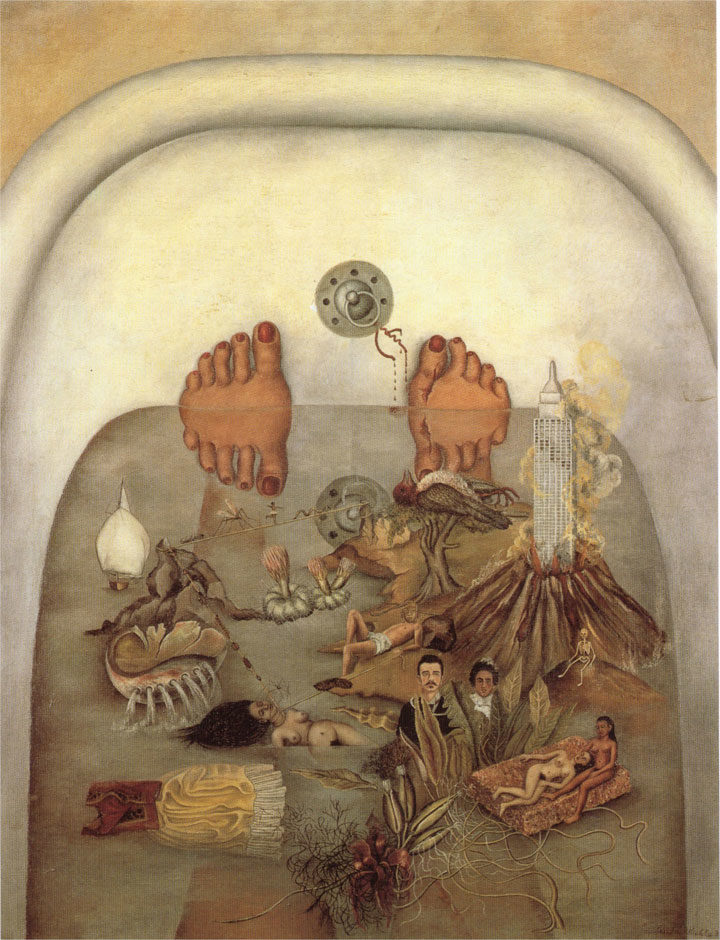
The other painting that inspired our broadside is What the Water Gave Me, painted in 1938. This is the first Frida Kahlo painting I (Chandler) ever saw—and it has, in a way, haunted me my entire life, even as my understanding of it has grown and changed as I’ve aged. This painting is largely known as Frida’s autobiography: scenes from her life, both joyful and painful, as well as symbolic figures are combined in a tableau reminiscent of an allegory by Hieronymous Bosch. These scenes float in a tub of bathwater in which she’s soaking her battered, scarred feet: both her bath and her unflinching self-reflection are rituals both soothing and possibly agonizing.
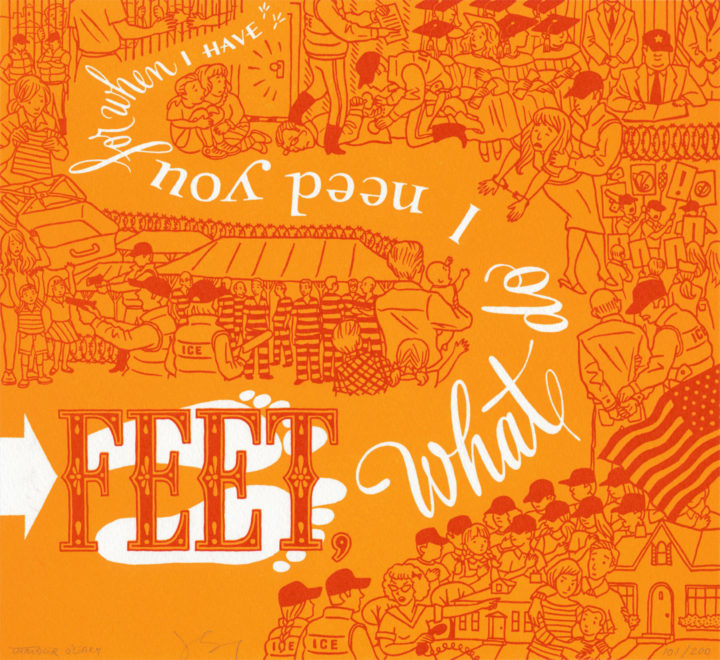
We tried to channel that unflinching gaze of Frida’s when we created this broadside. We’ve highlighted intolerance toward Latino-Americans and Spanish-speaking immigrants before in our Adina De Zavala broadside, but whereas we mostly dealt in metaphor and veiled symbolism then—the gloves are off now. Every time we heard of some new cruelty directed towards Latinx populations, our fury and disgust grew, and we funneled that rage into the design itself. The lower half of the illustration comes right out and says it: faceless ICE agents in red MAGA baseball caps arrest and threaten and round up and brutalize people, while civilians rat out their neighbors, carry tiki torches, turn a blind eye to injustice, or sign executive orders with their tiny hands.
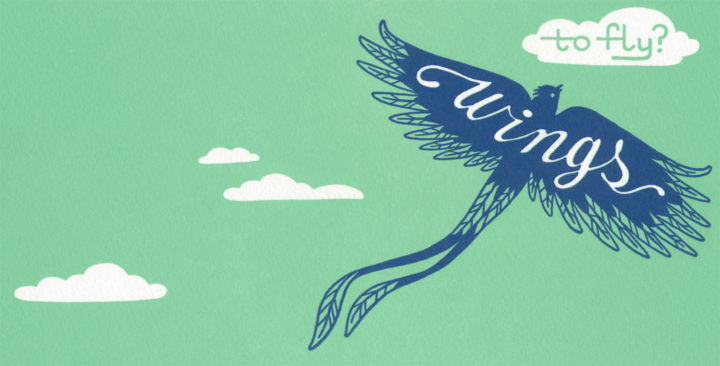
That said, our design is still filled to the brim with symbolism and layers of meaning, starting with the title. Estados Unidos is “United States” in Spanish, but we are anything but united right now—so our title is the Spanish translation of “Divided States.” Also, the bird taking wing is a quetzal—an ancient Mayan symbol of liberty and a more modern emblem of Central and South American culture. And because right now the whole world is upside-down, we’ve turned our paper upside-down, too. The deckle, that natural rag edge from the paper mold that you normally find at the bottom of our broadsides, is now at the top. (We think it gives Frida’s cloak a nice fluttery quality as her portrait presides over the composition.) The folksy, children’s-book illustration style contrasts sharply with the content of the lower half of the design. This is a jab at American exceptionalism and the fairytales we tell ourselves about who counts as “us” and who gets lumped in with “them.” That contrast of cheerful colors and serious subject matter is yet another nod to Frida’s life and work: she has frequently been referred to as “a ribbon around a bomb.”
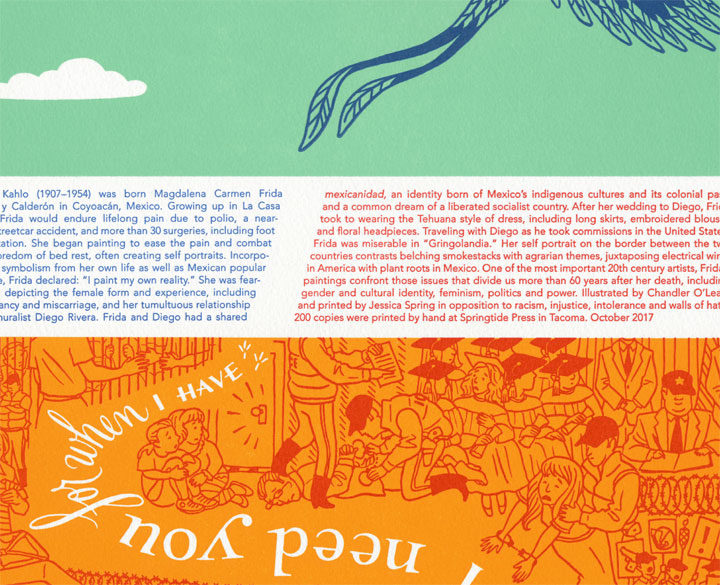
The two separate color schemes represent two worlds: Mexico and what Frida called “Gringolandia,” peace and war, heaven and hell, tolerance and bigotry, freedom and captivity, friend and foe. Like a flag—or a war zone—the two full-bleed color fields are sharply bifurcated by a no-man’s-land of Whiteness, representing the border wall of white supremacy that has long since been erected in America. Yet if you follow Frida’s words and footprints, starting in the trouble below and heading upward, you’ll find a way through—a path across the divide.
In recognition of this challenging duality, we are donating a portion of our proceeds to two different nonprofit organizations. One is Border Angels, a San Diego-based organization that provides free bilingual immigration services and consultations, as well as migrant and day-laborer aid and outreach—including border rescue stations and desert water drops. The other donation supports Northwest Immigrant Rights Project, a Seattle-Tacoma-based advocacy group that provides legal assistance to community members facing deportation. This is our second donation to NWIRP, acknowledging the very important and difficult work they tackle, especially in our hometown of Tacoma, at the Northwest Detention Center.
Purchase your copy in the shop!
• • • • • • • • • • • • • • • • • • • • • • • • • • • • • • • • • • • • • • • • • • • • • • • • • • • • • • • •
Estados Divididos: No. 26 in the Dead Feminists series
Edition size: 200
Poster size: 10 x 18 inches
Printed on an antique Vandercook Universal One press, on archival, 100% rag (cotton) paper. Each piece is numbered and signed by both artists.
Colophon reads:
Frida Kahlo (1907 – 1954) was born Magdalena Carmen Frida Kahlo y Calderón in Coyoacán, Mexico. Growing up in La Casa Azul, Frida would endure lifelong pain due to polio, a near-fatal streetcar accident, and more than 30 surgeries, including foot amputation. She began painting to ease the pain and combat the boredom of bed rest, often creating self portraits. Incorporating symbolism from her own life as well as Mexican popular culture, Frida declared: “I paint my own reality.” She was fearless in depicting the female form and experience, including pregnancy and miscarriage, and her tumultuous relationship with muralist Diego Rivera. Frida and Diego had a shared mexicanidad, an identity born of Mexico’s indigenous cultures and its colonial past, and a common dream of a liberated socialist country. After her wedding to Diego, Frida took to wearing the Tehuana style of dress, including long skirts, embroidered blouses and floral headpieces. Traveling with Diego as he took commissions in the United States, Frida was miserable in “Gringolandia.” Her self portrait on the border between the two countries contrasts belching smokestacks with agrarian themes, juxtaposing electrical wires in America with plant roots in Mexico. One of the most important 20th century artists, Frida’s paintings confront those issues that divide us more than 60 years after her death, including gender and cultural identity, feminism, politics and power.
Illustrated by Chandler O’Leary and printed by Jessica Spring in opposition to racism, injustice, intolerance and walls of hate.

November 10th, 2016

I finished this map before the airwaves were inundated with red and blue election maps—and today it’s a good reminder that America is more than its electoral divisions. That there is good in every state, and that there is so much to love and celebrate in every nook and cranny of our nation. This is why I started the 50 States project three years ago, and I’m taking the fact that I happened to finish the series right before the most divisive election in living memory as a sign that I need to remember this fact going forward. After all, the real work of our country involves all of us.
Those of you who read my travel blog know that I express my love for every state—blue, red, purple, whatever—through my drawings. I will continue to do so, to feature the beauty and wonder and hilarity and kooky humor of every state. That is what will get me through the fear and sadness and anger I’m feeling now—and I hope it will help you in some small measure, as well. So the break I took from blogging to focus on our book is over; Drawn the Road Again starts back up again tomorrow.
In the meantime, you can celebrate all 50 States with me tonight at the Ted Sanford Gallery at Charles Wright Academy in University Place, WA, where the entire series is on display through November 29. From 5:30 to 6:30 tonight I’ll have a gallery reception and small pop-up shop. Let’s talk about the good that’s out there—from Paul Bunyan to Elvis to the World’s Largest Frying Pan, and everything in between, from sea to shining sea.
November 9th, 2016
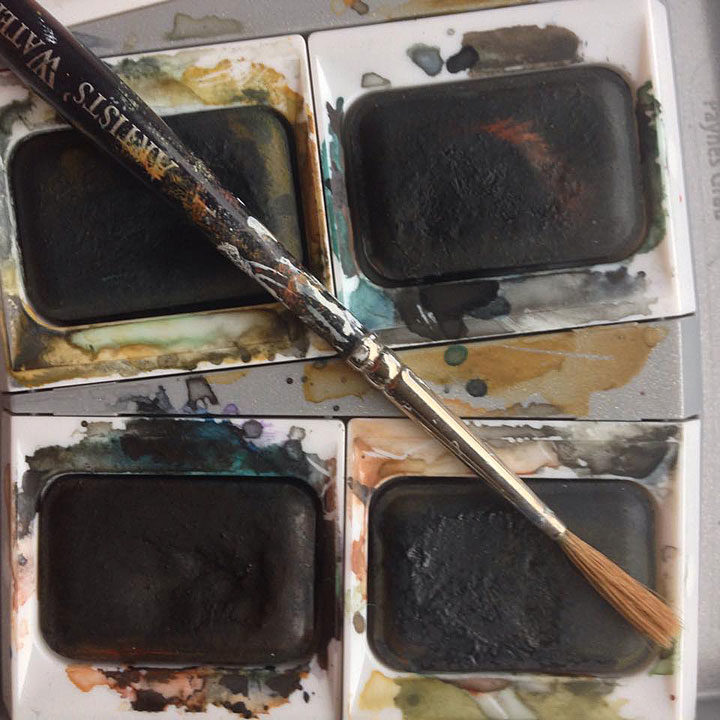
People tend to see me as relentlessly cheerful, and my work as vibrant and colorful. Today I have the Rolling Stones’ “Paint it Black” stuck in my head. Today I feel hurt, betrayed, shocked, fearful, bitter and white-hot with fury. Today I will quarantine myself from other humans to avoid lashing out and saying awful things. Today I will clean my messy studio and catch up on mindless tasks. Today I’m putting my proverbial house in order, because tomorrow I need to be ready to roll up my sleeves and get to work. We all do. #imstillwithher
November 8th, 2016
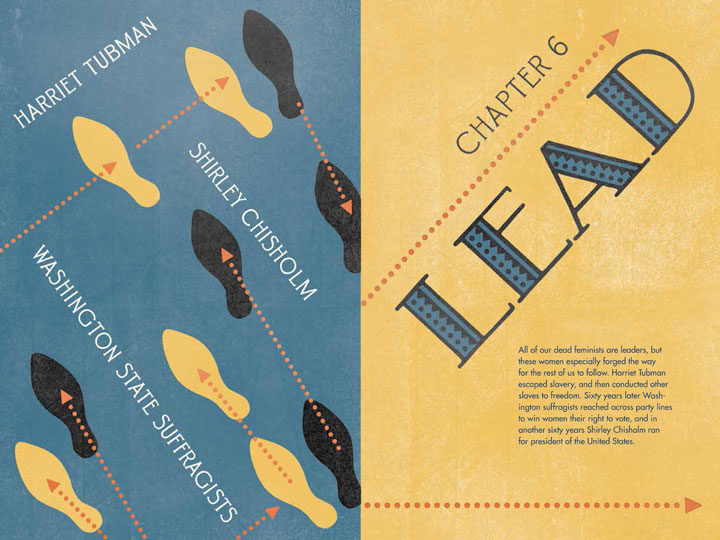
When we were coming up with the action-word titles for each chapter in our book, some words came to mind easily, while others were a challenge. Since we had to include three different feminists under each umbrella term, we had to think outside the box of each word’s literal meaning. “Lead,” though, was a no-brainer, and one of the first words that sprung to mind.
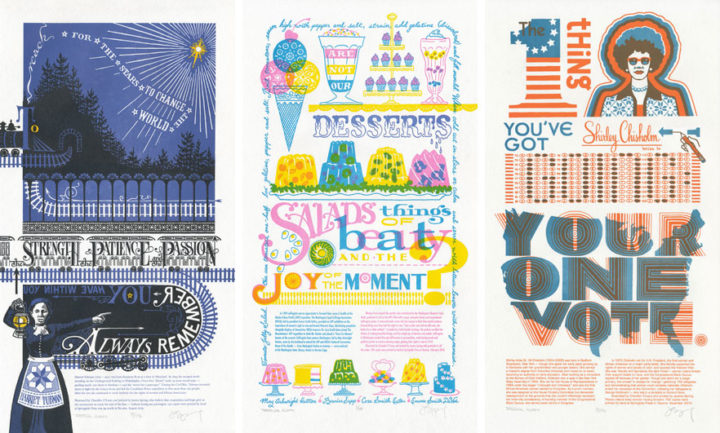
The women we featured in that chapter were all natural leaders, both literally and figuratively. Harriet Tubman, of course, literally led people to freedom in the North. The four members of the Washington suffrage movement led the way to gaining women in their state the vote. And Shirley Chisholm was elected to lead her constituents in the U.S. House of Representatives—then led the way as the first woman candidate on a major-party Presidential ticket.

So since today is Election Day in the U.S., Jessica and I have our minds occupied with the women who came before us, who forged the path that led us to where we are today. And we’ll be focusing on this topic in our talk today at the University of Puget Sound:
Pressing Matters: Election Day
Artist talk, book signing and pop-up shop
Today, November 8, at 4 pm, in room 020
Collins Memorial Library
University of Puget Sound, Tacoma, WA
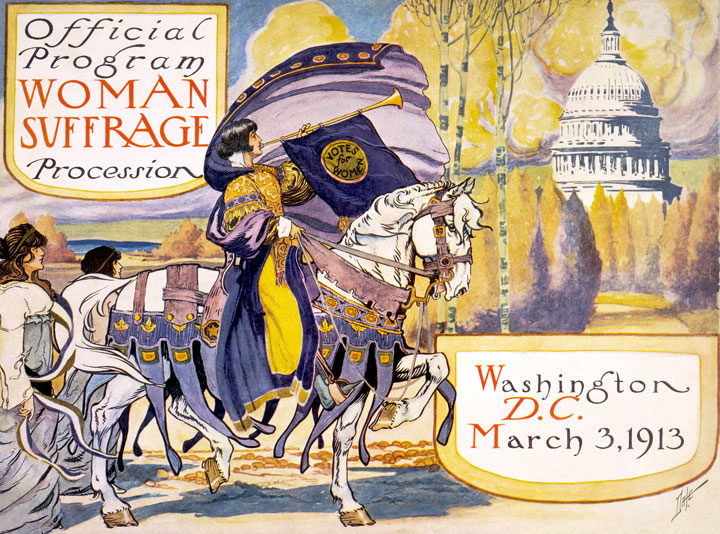
First came the seemingly endless fight to win women the vote—
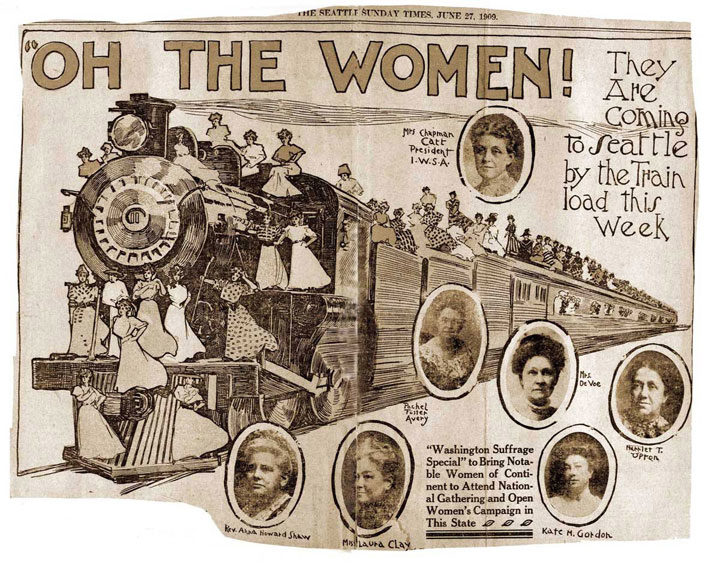
—not just nationally but also within their individual states. The amount of campaigning, organizing, writing, publishing, and picketing done by Emma Smith DeVoe and her colleagues was staggering, but their cumulative efforts built momentum that turned the campaign into an unstoppable train of force.
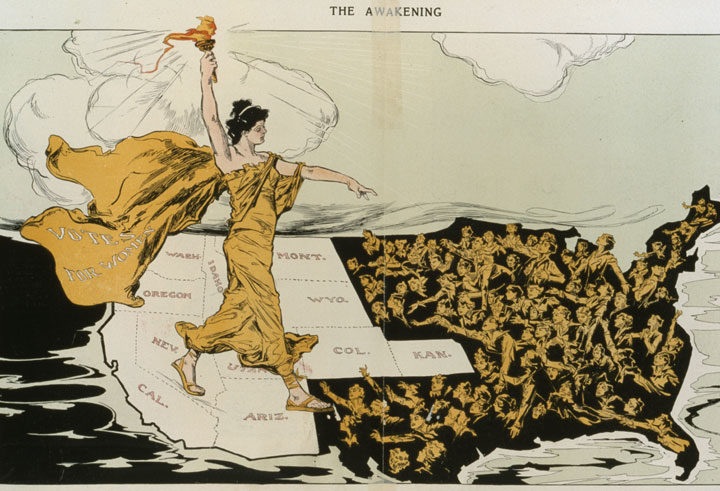
Since women in Washington gained the vote in 1910, a full decade before women could vote in national elections, the suffrage movement saw our region as progressive leaders, trailblazing the path to political equality.
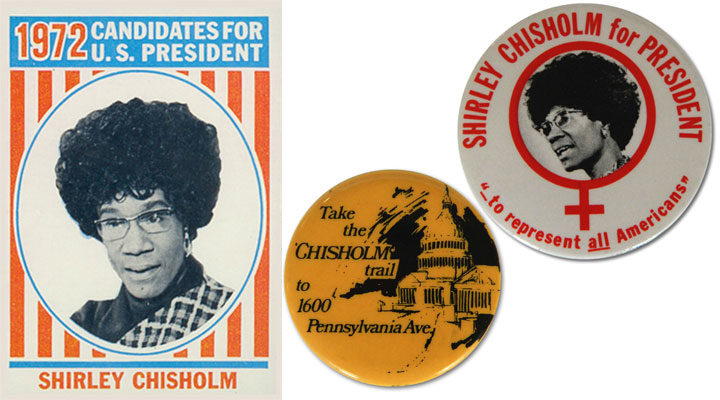
More than sixty years later, Shirley Chisholm took the lead by running for President, which made her, in her own words, “literally and figuratively the dark horse.” Though she lost the 1972 Democratic primaries in the end, she fought hard to make the path a little easier for any women who came after her.
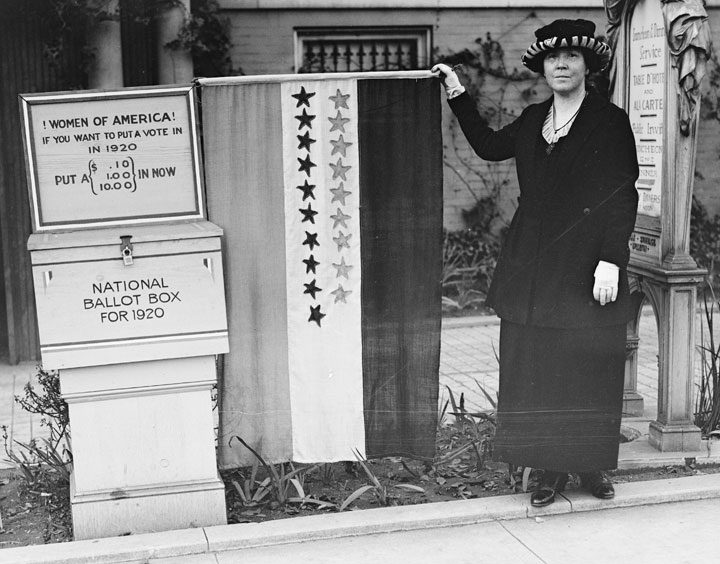
Today we stand on another historic threshold, where at long last, American women have the chance to vote for the first woman President—not just in the primaries, but in the main event. When we cast our ballots today, we’ll feel the presence of all the women who led the way.
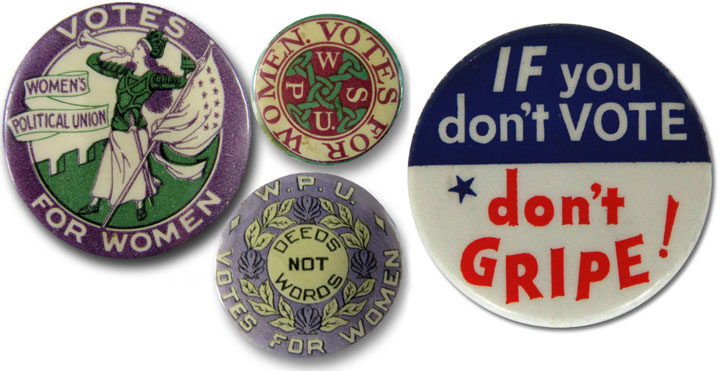
A century’s worth of campaign buttons has got it right: your vote counts, especially if you are a woman. Please get out and vote today, and help us make history, not just write about it.
October 25th, 2016
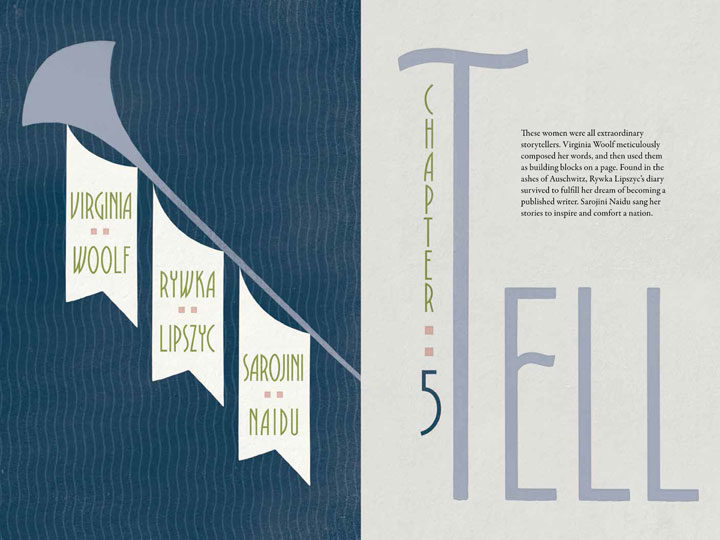
Dead Feminists: Historic Heroines in Living Color has been out in the world for a few weeks, and most folks have been excited (beyond our immediate families). A common response has been one of surprise: “it’s a real book!” Dashing expectations of a coffee table book, Dead Feminists is more than 180 pages of the women, history and social issues entangled in our series of broadsides. Questions about the writing process have come up, from assumptions that we worked with a “real” writer, or that Jessica did the writing while I illustrated. While we definitely worked with talented editors at Sasquatch Books who steered the book towards “real” bookness, both of us did the research, writing and photo research over nearly two years. We also both contributed imagery in the form of illustrations—hand-lettered images from me and beautifully-printed vintage cuts and patterns from Jessica.

Many of our dearest Dead Feminists are writers, artists, or both– evidence that we all find a way to tell our stories. Elizabeth Cady Stanton, who launched our series, wrote most of the speeches delivered by Susan B. Anthony. Some writers and their books are well known, like Gwendolyn Brooks and Rachel Carson—who both confronted ongoing challenging social and environmental issues—and their voices can guide us still. We have mere fragments of poetry from Sappho and carefully handwritten letters from Jane Mecom to her brother—they give us insights into their lives and eras when words from women weren’t often valued or recorded. In the chapter entitled Tell, we focused especially on women who had stories to share, like Virginia Woolf, who carefully crafted and composed both the pages and handset type for printing. Knowing the time and care involved, there is little doubt in my mind that the act of being writer and printer sharpens both crafts.
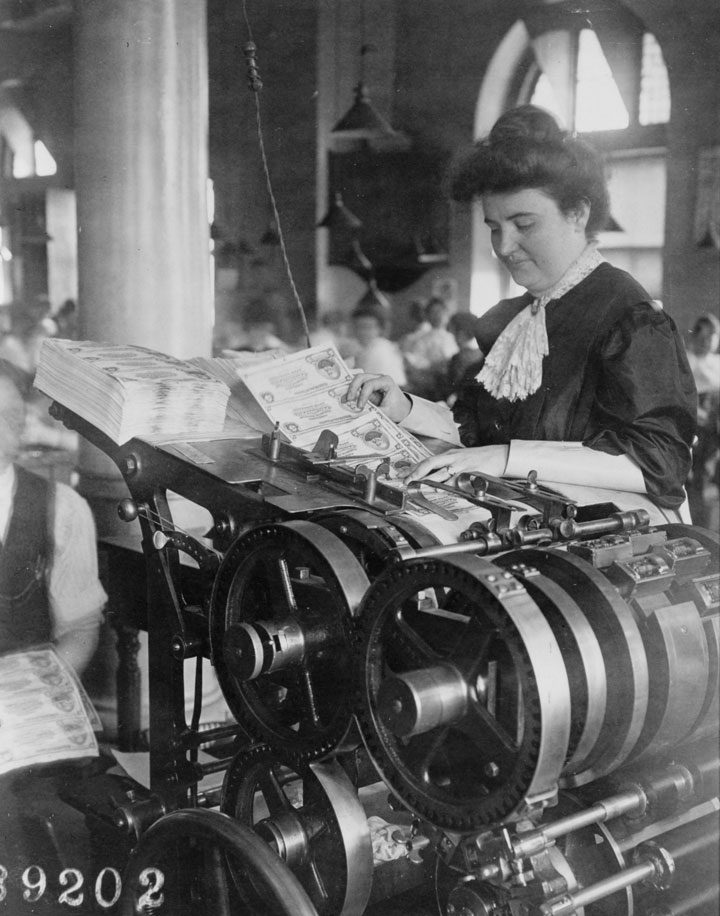
Without the discovery of Rywka Lipszyc’s diary found in the ashes of a Auschwitz crematorium she would have disappeared from history. Sarojini Naidu dreamed of independence for India through her poetry (“Waken, O slumber Mother and be crowned”) and was revered as a nightingale, filling the night air with song. We hope you’ll explore these stories more in depth through the book—and for local folks we have some opportunities in the next few weeks to join us in person.
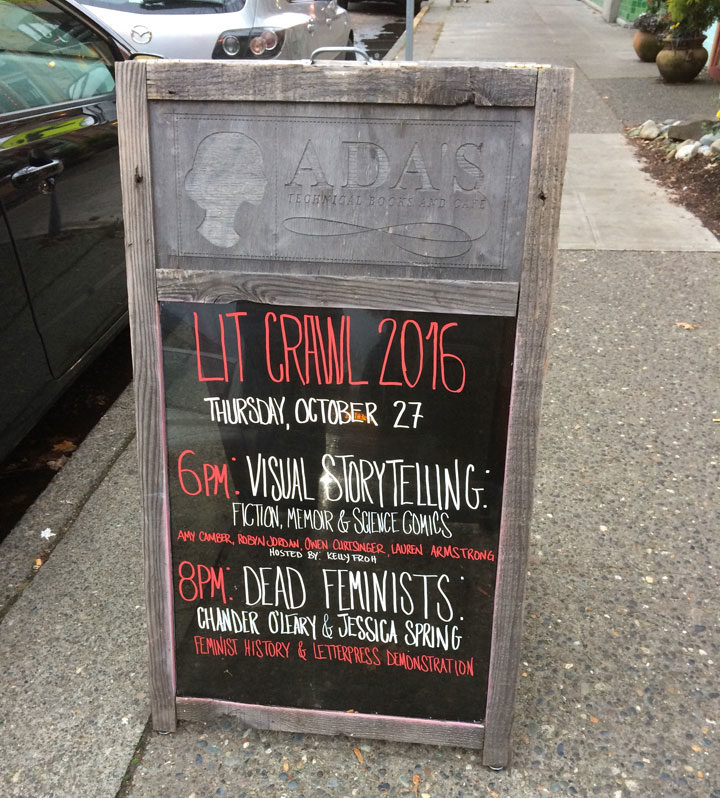
Here’s what’s coming up this week and next, when you’ll find us invading first Seattle, then Portland. You can find future events and more info on our events page.
LIT CRAWL Seattle: Book signing and artist talk
Thursday, October 27, 2016, 8 pm
Ada’s Technical Books and Cafe
425 15th Ave. E, Seattle, WA
BROADS AND BROADSIDES
A retrospective exhibition featuring our series through broadsides and steamroller prints
Reception, book signing & costume party
Come dressed as your favorite historical feminist!
Saturday, October 29, 4 to 7 pm (the show continues through December 16th)
October 29 through December 16, 2016
School of Visual Concepts
2300 7th Ave., Seattle,WA
DEAD FEMINISTS and RAD WOMEN: joint author event
with Kate Schatz and Miriam Klein Stahl, authors of Rad Women Worldwide
Thursday, November 3, 2016, 7:30 pm
Powell’s Books on Hawthorne
3723 SE Hawthorne Blvd, Portland, OR
LIT CRAWL Portland: Book signing and artist talk
Friday, November 4, 2016, 8 pm
The Big Legrowlski
812 NW Couch St., Portland, OR
WORDSTOCK: Portland’s Book Festival
Chandler & Jessica appearing on an author panel
with Danielle Dutton, author of Margaret the First
and Laurie Notaro, author of Crossing the Horizon
moderated by Elly Blue of Microcosm Press
Book signing to follow
Saturday, November 5, 2016, 1:30 pm
The Old Church
1422 SW 11th Avenue, Portland, OR
BEACH BROADS(ides)
book signing and artist talk on the gorgeous Oregon coast!
Saturday, November 5, 2016, 6:30 pm
Beach Books
616 Broadway, Seaside, OR
Save
Save
October 13th, 2016
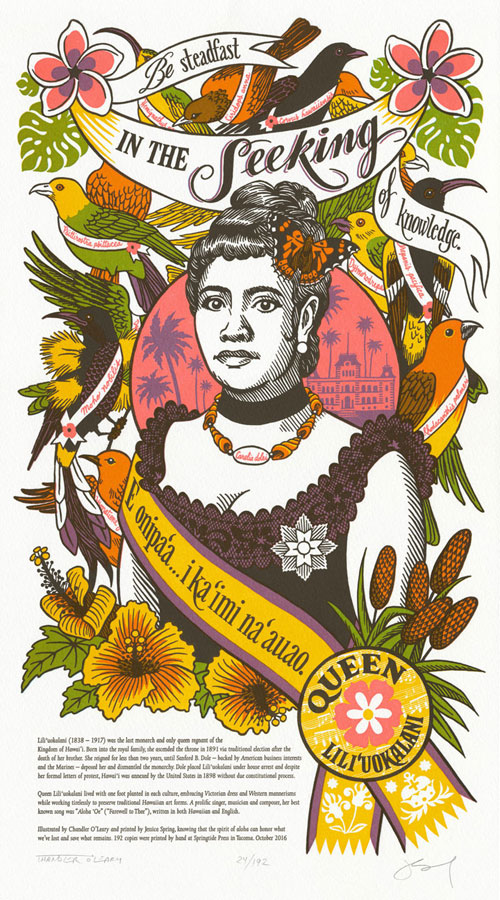
When we wrote and illustrated our new book, Dead Feminists: Historical Heroines in Living Color, it was important both to us and the publisher that we fill the pages with new content, rather than simply rehash the story of our previous broadsides. So it came to us that one great way to do that would be to have a new broadside appear in the book and in the world simultaneously. One of the biggest challenges of doing this (other than having to print the broadside ahead of publication and then keep the secret for months) was choosing who to feature, considering the fact that we’d be introducing the broadside to a brand new and much larger audience. We wanted to feature a woman who touched the world, and who reflected the world we had become.
We live in a global society, with different cultures mingling—and at times clashing—with a regularity we now take for granted. It is easy to forget the imperialist origins of globalization, where Western cultures sought to dominate and even extinguish the societies they encountered. Colonization of the Indigenous world has had far-reaching effects on both people and the environment, the consequences of which we are only beginning to understand. And who better to understand the ripple effects of colonialism than the queen of a colonized nation?
“E onipai’a . . . i ka ‘imi na’auao.” (“Be steadfast in the seeking of knowledge.”)
— Queen Lili’uokalani
Queen Lili’uokalani was the last monarch—and only queen regnant—of the Kingdom of Hawai’i. Raised by traditional Hawaiian custom and a resident of a post-colonial country, she was fluent in the ways of both Hawaiian and Western cultures. Her reign was sadly brief—thanks to powerful foreign interests who refused to share the nation they had claimed for their own. Yet she devoted much of her life to preserving traditional art forms and recording them for others to study. Hers was the middle road—the road of survival.
For Indigenous women like Queen Lili’uokalani, there is no going back to life before Euro-American contact. Yet Lili’uokalani led a life that included and celebrated both the culture of her birth and the one imposed upon her later in life. Her example of sharing both traditions with future generations helps us all create a path forward. We are especially thankful to Alison Milham, a Hawaiian book artist who has extensively researched the Queen and who helped us fine tune our message.
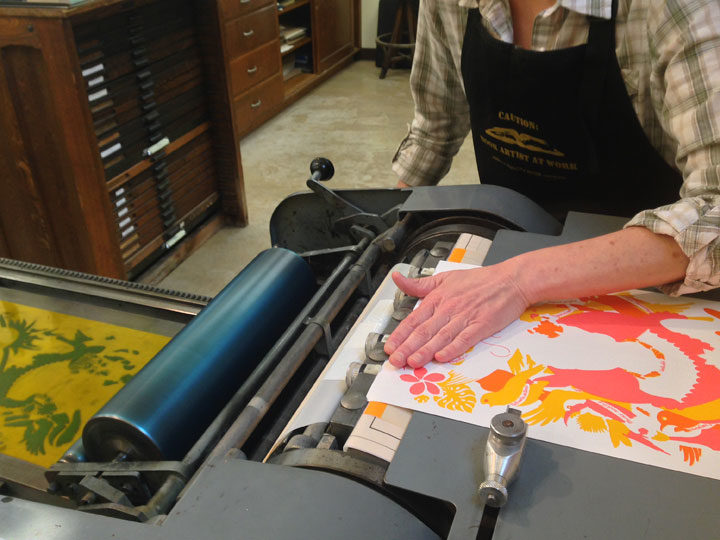
Jessica and I have our own paths to walk when it comes to creating each new broadside in our series. In my case, I’m always eager to explore different historical eras and design styles. And Jessica is constantly looking to push the envelope of what’s possible with letterpress printing—she loves to experiment with different techniques, like the split-fountain inking on our Nightsong broadside, or the crazy metallics of Focal Point, or the large floods and knocked-out shapes of Title Nine Iron. This time we wanted to create a tropical rainbow, but rather than printing every letter in ROYGBIV separately, we puzzled out how to create an illusion of a full-color design with translucent, overlapping colors, which Jessica would print in just four passes on press.
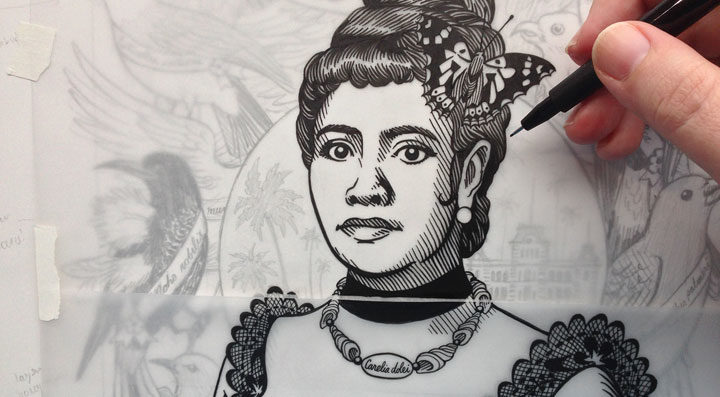
Jessica’s job was extra tricky, since the different plates had to line up perfectly to make the illusion work. But my end of the process was confusing, too: since I do the original drawing in black and separate the colors by hand, I had to keep checking and re-checking to make sure I didn’t assign some blob of color on the design to the wrong plate.
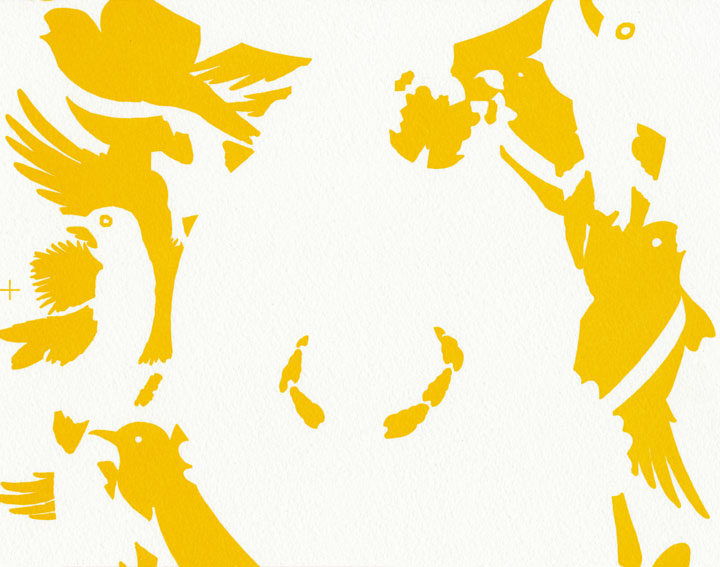
Generally speaking, we usually print our colors from lightest to darkest. So this time we started with a deep saffron yellow—the color of royalty in the Kingdom of Hawai’i, and one symbolic of Queen Lili’uokalani’s reign.
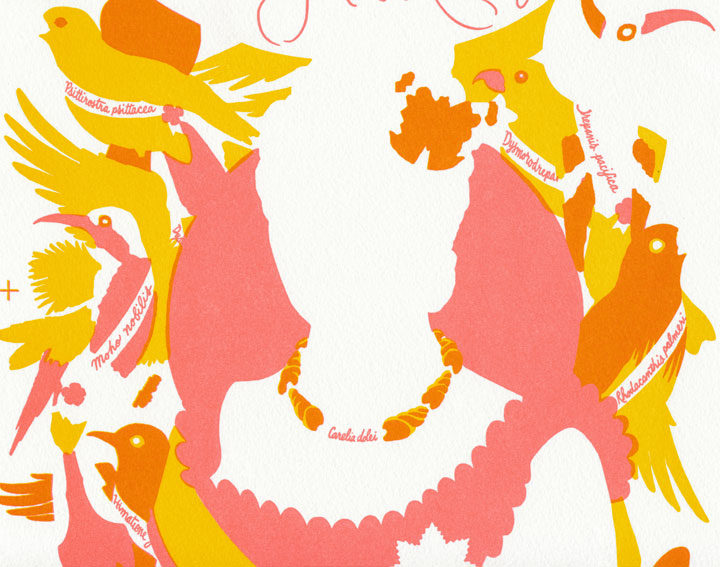
Then we overlaid a hot-hot pink on top of the yellow, one that stood in both for tropical flowers and the blazing color of the sun setting on Hawai’i’s Indigenous rulers. Wherever the pink overlapped the gold, the ink mixed to create a fiery orange.
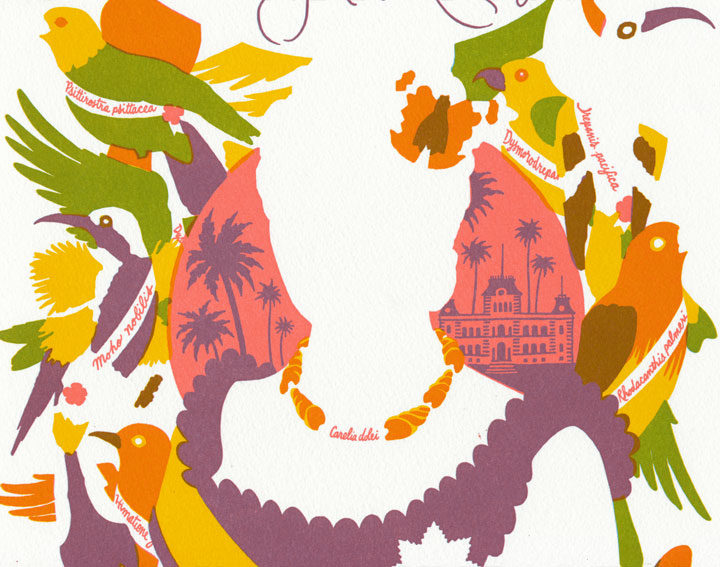
Next came a pass of cerulean blue. This part might seem confusing, because you can’t actually see any blue in the finished piece (though you can see it on press on the photo of Jessica above), but it’s an essential ingredient of our color scheme. Wherever the blue overlaid yellow, we got green. Where it hit that hot pink, a royal purple resulted. And where it touched any orange areas that resulted from the previous pass, a russet brown appeared.
Finally, we were ready for our last color, a rich black (actually, Jessica ran that last pass twice—the double hit of black made the ink nice and opaque) that brought everything together into harmony:
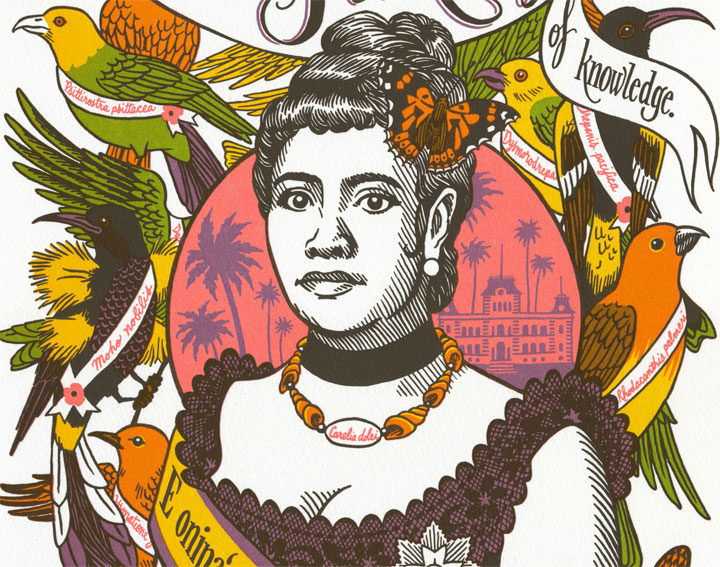
Our 24th broadside, Song of Aloha, depicts the lush flora and unique fauna of Hawai’i. Plumeria and hibiscus bloom, while leaves and fronds stand in silhouette in homage to traditional Hawaiian quilt motifs. At the center of the design is Queen Lili’uokalani herself, wearing a sash in royal colors, her signature brooch, a necklace of shells (from the extinct species Carelia dolei) and a Kamehameha butterfly in her hair. As a symbol of the vanished Hawaiian monarchy, every bird pictured is an extinct Hawaiian species—including the greater koa finch, the Hawai’i mamo, the Lana’i hookbill, the Hawaiian crow, and several species of endemic honeycreeper that now only exist as museum specimens.
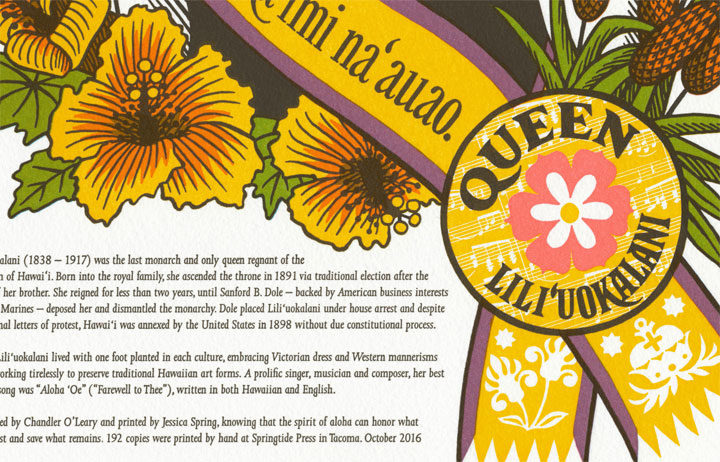
Oh, and hidden in the design are ‘Iolani Palace and a line of music from Lili’uokalani’s famous composition, “Aloha ‘Oe.”
This piece marks the inauguration of the Dead Feminists Fund, to which a portion of our proceeds (and those of our new book!) will be donated. In honor of the power of women’s work, the Fund supports nonprofits that empower girls and women to create change in their own communities.
• • • • • • • • • • • • • • • • • • • • • • • • • • • • • • • • • • • • • • • • • • • • • • • • • • • • • • • •
Song of Aloha: No. 24 in the Dead Feminists series
Edition size: 192 prints
Poster size: 10 x 18 inches
Printed on an antique Vandercook Universal One press, on archival, 100% rag (cotton) paper. Each piece is numbered and signed by both artists.
Colophon reads:
Lili’uokalani (1838 – 1917) was the last monarch and only queen regnant of the Kingdom of Hawai’i. Born into the royal family, she ascended the throne in 1891 via traditional election after the death of her brother. She reigned for less than two years, until Sanford B. Dole—backed by American business interests and the Marines—deposed her and dismantled the monarchy. Dole placed Lili’uokalani under house arrest and despite her formal letters of protest, Hawai’i was annexed by the United States in 1898 without due constitutional process.
Queen Lili’uokalani lived with one foot planted in each culture, embracing Victorian dress and Western mannerisms while working tirelessly to preserve traditional Hawaiian art forms. A prolific singer, musician and composer, her best known song was “Aloha ‘Oe” (“Farewell to Thee”), written in both Hawaiian and English.
Illustrated by Chandler O’Leary and printed by Jessica Spring, knowing that the spirit of aloha can honor what we’ve lost and save what remains.
Now available in the shop! Or for local folks, you’ll find it at Studio Tour this weekend!
Save
Save
Save
Save
October 12th, 2016
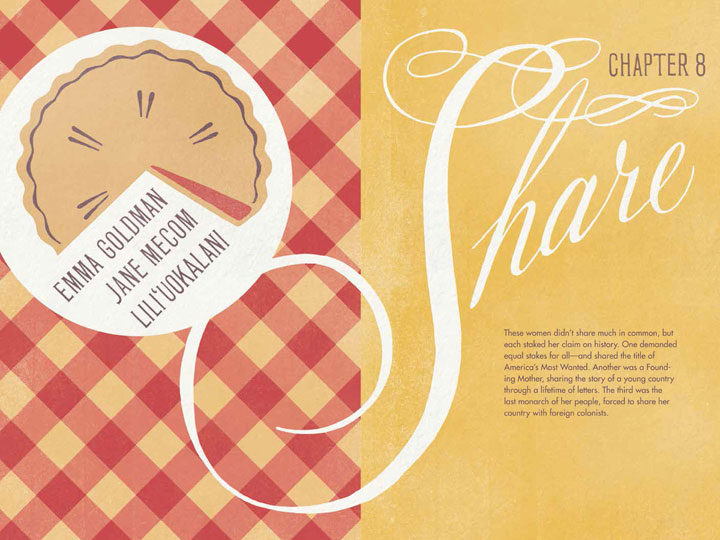
Earlier we shared some sneak peeks of the chapter spreads, but now that our book is out we can tell you a bit more about how the book is structured.
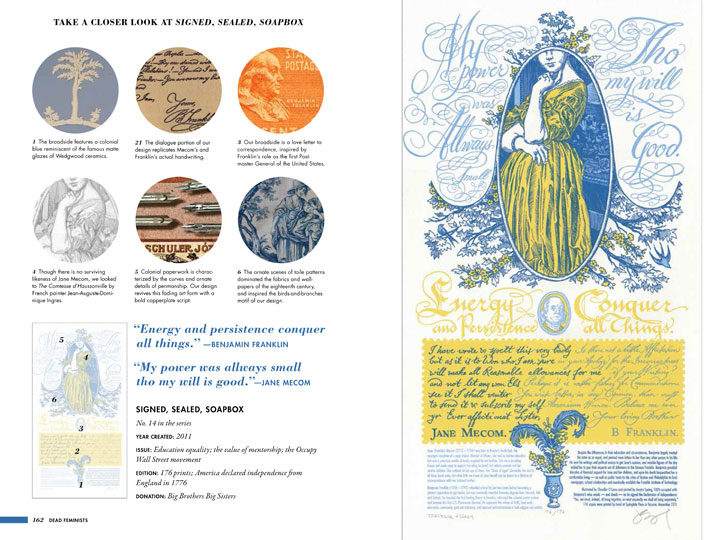
Of course, we go into detail about the process and stories behind each of our broadsides, including a “director’s cut” of each print.
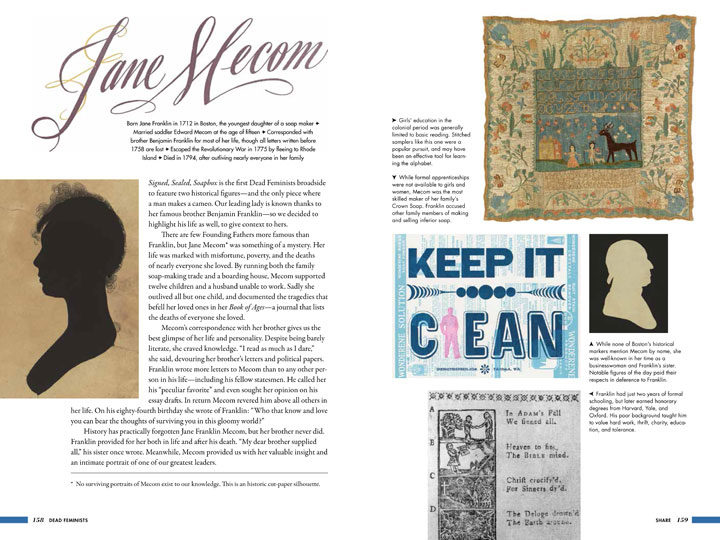
The great thing about the book format, though, is the ability to expand beyond the short colophons we include on each broadside. So each chapter goes in-depth about the women we featured and the social issues we highlighted with each broadside. Each story is anchored with archival photos and vintage ephemera to paint a more complete picture of these 27 women and their lives.
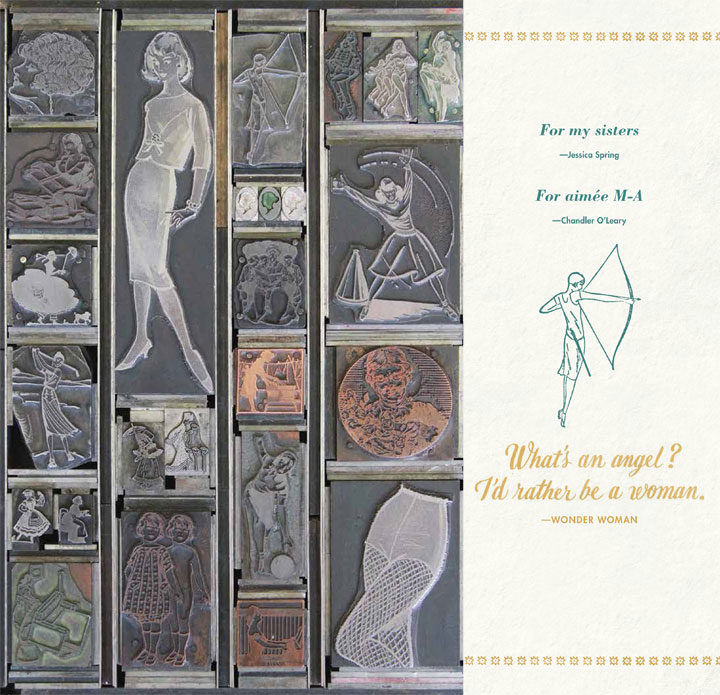
To tie everything together and reinforce our letterpress roots, the pages are peppered with vintage hand-set metal and wood cuts from Jessica’s incredible collection. Each one appears like an easter egg, linking our content to our process and bringing the past to life in the present.
Major thanks to our amazing editorial and marketing team at Sasquatch Books—every member of which is a fellow woman—for getting us to this point, and for continuing to support the Dead Feminists Fund through a portion of every book sale. And last but not least, thank you for supporting our series and our book. We hope that reading the book will be as rewarding for you as it was for us to write it.
See you tomorrow with more information about our 24th broadside!
October 11th, 2016
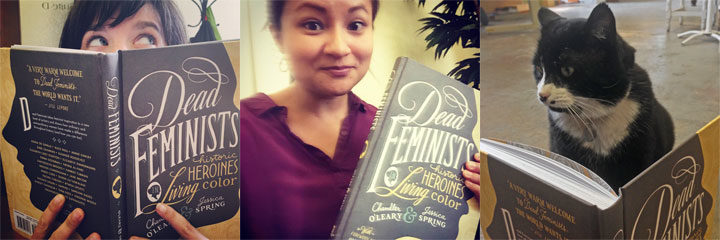
People everywhere can finally read our book, because today is the official release date! You can find your copy wherever books are sold—you’ll find all the major retailers on our book page.
If you’re in the Seattle-Tacoma area, just a reminder that you can pick up your copy tonight (and see Jessica and me in costume) at our official release party at King’s Books!
Official Book Release Costume Party
Tuesday, October 11, 7 pm
Hosted by King’s Books
218 St. Helens Avenue, Tacoma, WA
Event is free, all ages welcome; more info here
Come in costume, dressed as your favorite historical feminist!
We’d also love to see you at Tacoma’s Studio Tours, happening this Saturday and Sunday. This is our biggest event of the year, where we join more than 50 Tacoma artists for a city-wide free event. We’ll be selling (and signing) copies of our book at the event, as well our new Dead Feminists broadside and a special new mini letterpress print. We’ll also have a host of new gifts and stationery for sale, plus free hands-on activities: print your own keepsakes at Jessica’s studio, and create a die-cut greeting card at my place. Sstamp your Studio Tour Passport at at least 8 stops on the tour, you can enter a drawing for a variety of artist-made prizes. Here’s the scoop:
Tacoma Studio Tours
This Saturday & Sunday, October 15 & 16
11 am to 5 pm, free!
Chandler is stop #9; Jessica is stop #15
More info and maps here
If you’ll excuse us, we have some costumes to get into… See you tonight!
October 6th, 2016
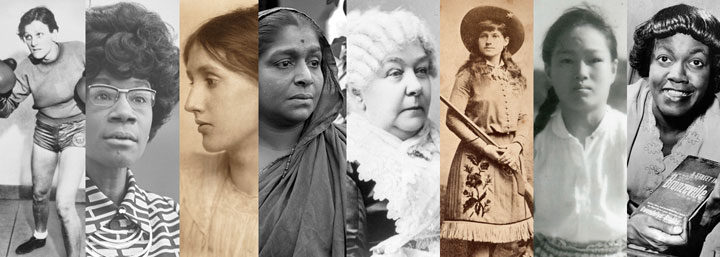
Tuesday is the day! Our book will be released worldwide on October 11, and we’re celebrating with a costume party! This is where you can be the first to get your hands on the book—and extra worth the effort if you want to see Jessica and me wearing ridiculous wigs. We don’t want to be the only ones celebrating Halloween early, so come on down and join the party. We’ll have prizes for the best outfits, Dead Feminists cake and punch, and a printing press ready to make your own keepsake. We’d love to sign a book for you, too. If you’re looking for costume ideas, you might dress up as one of the ladies in our book…
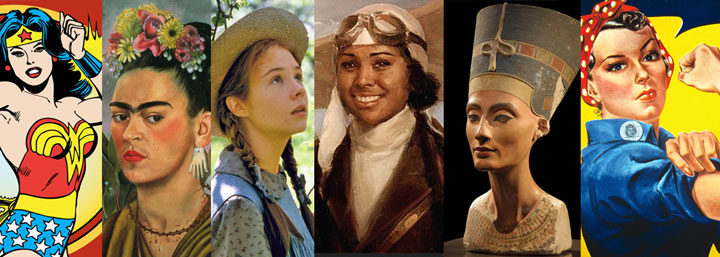
…or you might choose another favorite historical heroine, or a beloved fictional character, or even an historic feminist dude! Anything goes, and we can’t wait to see what you come up with. Here’s the skinny on the event:
Official Book Release Costume Party
Tuesday, October 11, 7 pm
Hosted by King’s Books
218 St. Helens Avenue, Tacoma, WA
Event is free, all ages welcome; more info here
Come in costume, dressed as your favorite historical feminist!
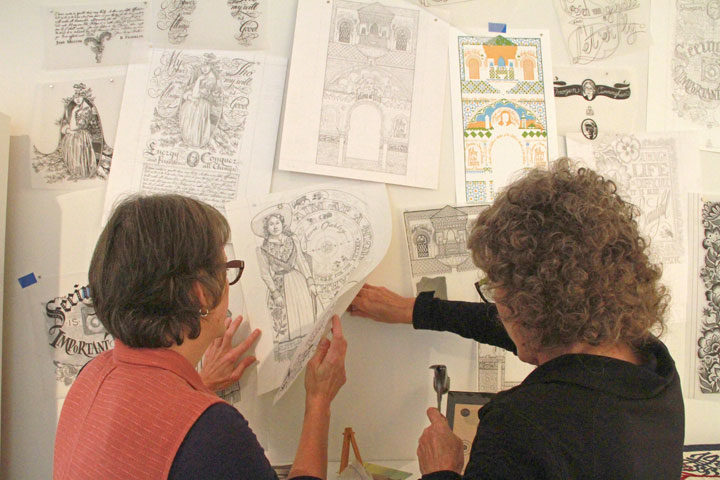
In addition to finally sharing the book with you next week, we also wanted the chance to share some of our original artwork. So for the past two years we’ve been planning a big retrospective exhibit with the 23Sandy Gallery in Portland, OR. Laura Russell, the owner and curator of the gallery, has been a major supporter of our series since the beginning—and this week it was no different, as she jumped right in and helped us install our artwork in her space!
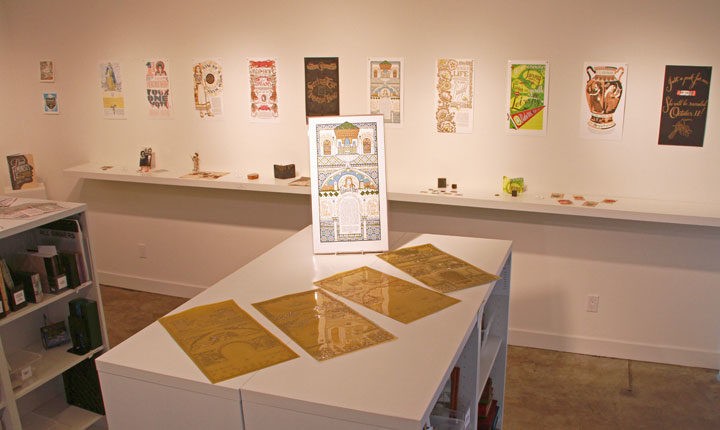
The show features 10 original letterpress broadsides from our series, two mini-broadsides, original process materials, plus vintage ephemera from our book. This is the first time we’ve done a show like this, and 23Sandy is the only place you’ll still find some of our older, out-of-print broadsides available for sale.
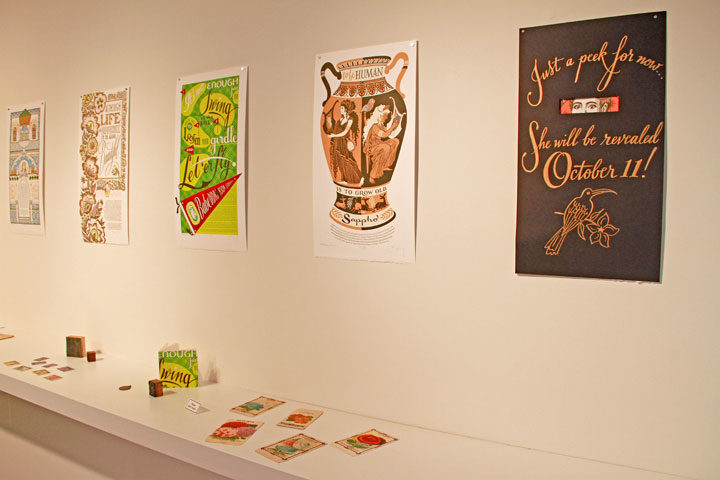
The exhibit also includes our 24th and newest broadside, but since she comes out on October 11, alongside the book, we have her hidden under a black veil for now. But you can see her—and all the other artwork—unveiled at our reception and book signing later this month. Here are the details:
Make-Ready: Dead Feminists from Print to Page
A Dead Feminists retrospective exhibit
on display through October 29
Reception & book signing Saturday, October 22
4 to 6 pm, free!
23Sandy Gallery
623 NE 23rd Ave, Portland, OR
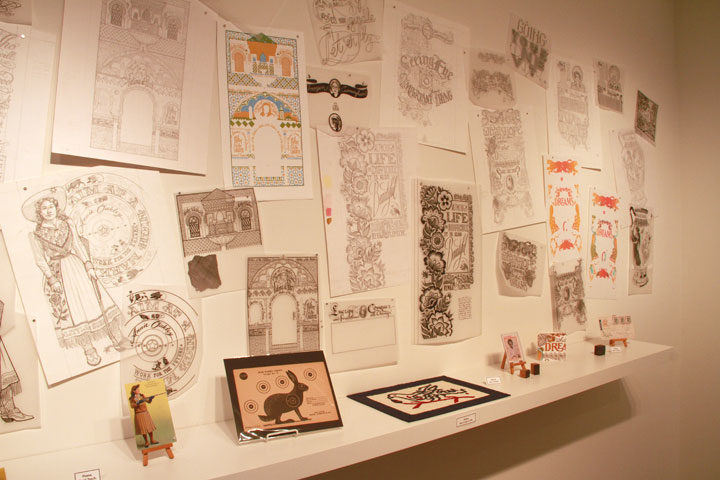
If you can’t make it to Portland, you can also learn more about the exhibit and view an online catalog on the 23Sandy website.
Make-Ready is just one of many different exhibits in the works this fall—we’ve got the Dead Feminists coming to galleries around the country for both solo and group shows. We’ll be sharing more info here on the blog soon, but as always, you can find all our events, shows, book signings and talks listed on the events page.
See you Tuesday—in costume!
Save
September 27th, 2016
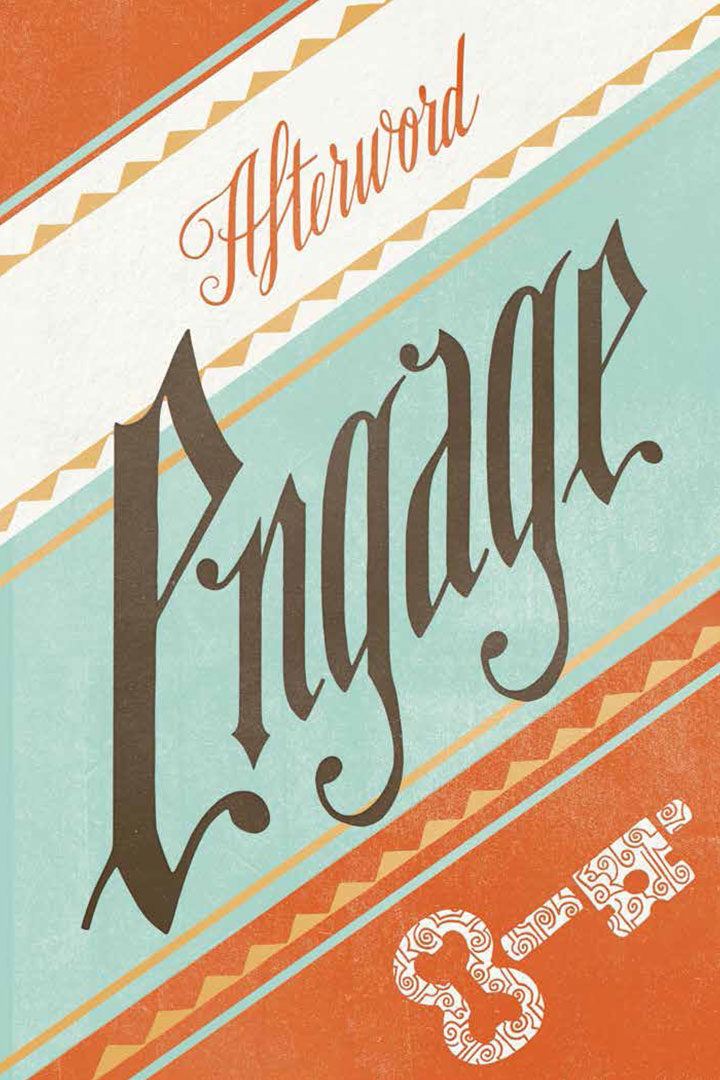
One of the biggest challenges of turning the Dead Feminists into a book was figuring out a way to tie all our broadsides together in a way that was engaging for the reader. Aside from the size and format of each broadside, our prints had little in common with one another. Our feminists were a diverse group without much of an underlying thread—even the style of illustration was different for each one.

Jessica came up with the solution: using action verbs to tell our story. After all, our aim with the series was to use the literal and figurative power of the press to change the world around us. The women we featured had also created change—they were active, not passive. So we divided our 24 feminists among eight action words, choosing for each chapter a trio of women who shared qualities or deeds with that particular verb. And since we’re so close to the release of the book (just two weeks!), we thought we’d share a few of those words with you.
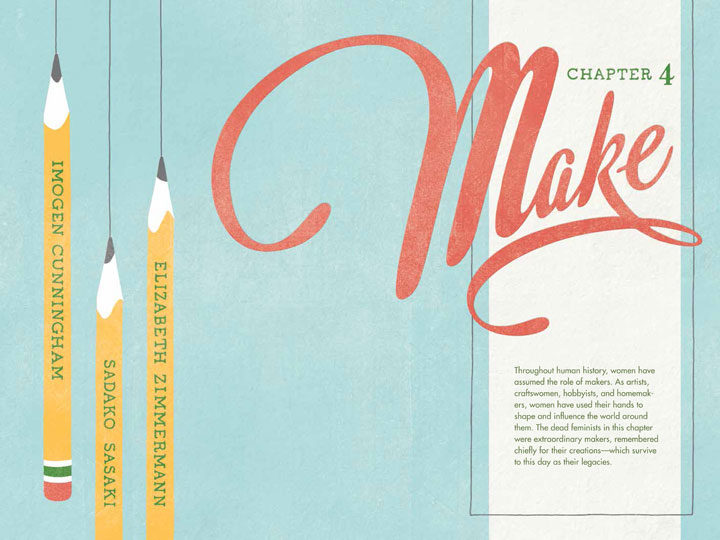
The best part for me, of course, was being able to make more hand-lettered illustrations! Each chapter’s verb is done in a different style, and elements of that illustration are carried throughout the rest of the chapter.
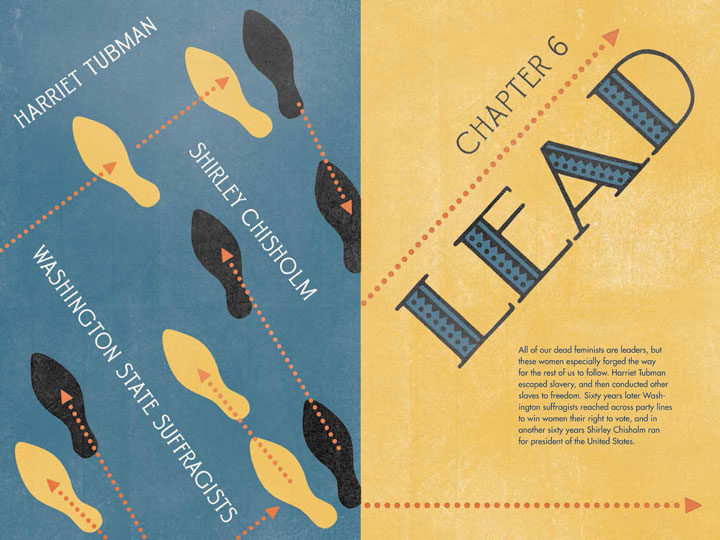
Of course, shoe-horning each feminist into one of the eight action themes was sometimes a convoluted business, but we got there in the end. We’re super pleased with how it all turned out—and hopeful that it might inspire more women and girls to take the lead with some action of their own.



![Chandler O'Leary [logo]](https://chandleroleary.com/wp-content/themes/chandleroleary/images/logo.png)









































